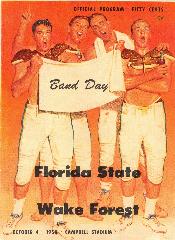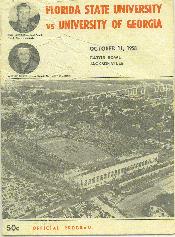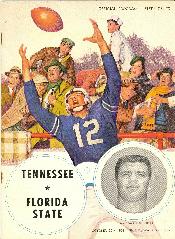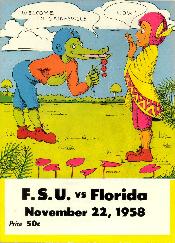



History of FSU Football: 1958 - Fifty Years Ago
By Jim Joanos
In the fall of 1958, Florida State University fans, in only the 12th season after the restart of the football program, were hungry for respect. They were also quite excited in that finally the Seminoles would have the opportunity to play the University of Florida at the end of the regular season. It would be the first FSU vs UF game in modern times and it had taken acts of government to schedule it. Legislative attempts to force the game and the promise of more to come along with pressure from numerous public officials had eventually forced the University of Florida to agree to play the Seminoles.
Tom Nugent had been hired in 1953 to lead the Seminoles' transition from small college powerhouse into the world of big time college football. Early on he had success. His 1954 team, after an 8 and 3 regular season had been invited and played in the prestigious Sun Bowl game in El Paso, Texas. FSU teams were winning a few more games than they were losing. But, for the most part, the football program had not yet reached the big time. The victories were mainly over schools absent from the top echelon in college football. The most important victories had been over schools like FSU that were trying to build their programs...teams like North Carolina State, Virginia Tech and Wake Forest. The schedules each year listed only a sprinkling of the "big name" schools like Georgia, Georgia Tech and Miami, and against those teams, while playing competitively, the Seminoles had not yet beaten any of them. In 1958 that changed. That year, FSU attained much of the prestige and respect that it was looking for.
Four very important events occurred in that 1958 season: (1) FSU obtained its first ever victory over an established Southeastern Conference opponent, Tennessee; (2) the Seminoles beat the University of Miami team for the first time; (3) the annual rivalry with the University of Florida began; and (4) for the first time, FSU played in a nationally televised football game, the Bluegrass Bowl game.
The first two games of the 1958 season were played by the Seminoles at home in Campbell Stadium and were easy victories. They beat Tennessee Tech, 22-7, and Furman, 42- 6. The third game was played at Georgia Tech and the Seminoles lost, 3 -17. They next beat Wake Forest at home in a close fought 27-24 encounter. The crowd of 19,700 fans that attended the game set a new record for Doak Campbell Stadium. This was followed by a loss to Georgia, 13-28, in a game played in Jacksonville's Gator Bowl. In the sixth game of the season, FSU, at home, shutout Virginia Tech, 28-0 in the rain.
At this point, FSU's record looked pretty good at 4-2 but as in previous years, they had not beaten a well established football program. In their two opportunities earlier, at Georgia Tech and Georgia, they had lost both games. FSU badly needed a victory over an established football team. That finally happened on October 25, 1958, in Knoxville, Tennessee, when the Seminoles, beat the Tennessee Volunteers, 10-0, for their first victory ever over a Southeastern Conference team.
There are lots of good stories about that game. FSU's two captains were two Tennessee natives, quarterback Joe Majors, and back Fred Pickard. Majors had an outstanding game that day leading the Seminoles. His brother, Billy, played quarterback for Tennessee but was injured early in the game and did not play any more. FSU's Pickard, from Columbia, Tennessee, led all ball carriers in gaining 133 yards for the day. The University of Tennessee had not recruited Pickard because as a 133-pound high school running back he was considered too small to play major college ball.
Bill McGrotha in his 1987 book, Seminoles! The First Forty Years, wrote about the welcome home that the team received following the game: "Thousands of welcoming fans - among them Gov. LeRoy Collins - swarmed Tallahassee's old airport at Dale Mabry Field as FSU's chartered flight returned from what some still consider the Seminoles' biggest victory of all time."
The Seminoles followed the victory over Tennessee with a joyous homecoming win over Tampa, 43-0, and six days after that beat the University of Miami for the first time ever, 17-6, in a game played in Miami's Orange Bowl Stadium. The Seminoles had failed in five earlier attempts.
In the last game of the regular season, the Seminoles played the Gators in Gainesville. FSU received the opening kickoff and the game started off with a bang. Halfback Jack Espenship got the ball and handed off to Bobby Renn who followed blocker Bob Swoszowski. Seventy-eight yards later, Renn was tackled on the Gator fifteen yard line. Shortly afterwards, the Seminoles scored and it was 7-0. Although FSU played tough throughout most of the game, five turnovers were costly and the outmanned Seminoles lost, 21-7. Despite the loss, a big time rivalry was born.
Thus the regular season ended with the Seminoles sporting a fine 7-3 record. It was good enough to get an invitation for FSU to meet Oklahoma A & M (now known as Oklahoma State) in a newly organized bowl game named the "Bluegrass Bowl" in Louisville, Kentucky. The game, on December 13, 1958, was broadcast to a nationwide audience, the first such game for FSU. The Seminoles lost that game, 6 to 15, in freezing cold weather. The turf was so hard that both teams had trouble just standing up. Because it was so very cold, very few fans attended and as a consequence no more Bluegrass Bowl games were played thereafter. An interesting tidbit about that game was that the primary television broadcast commentator was a little known lawyer who went on to great fame in the television sports world, Howard Cosell.
Despite the fiasco in the Bluegrass Bowl, the Seminoles in 1958 had accomplished a great deal. It had been a special year setting the stage for lots of special years to follow. Tom Nugent left FSU after that season. He was followed by a guy named, Perry Moss, but that is a story for another day.
 |
 |
 |
 |